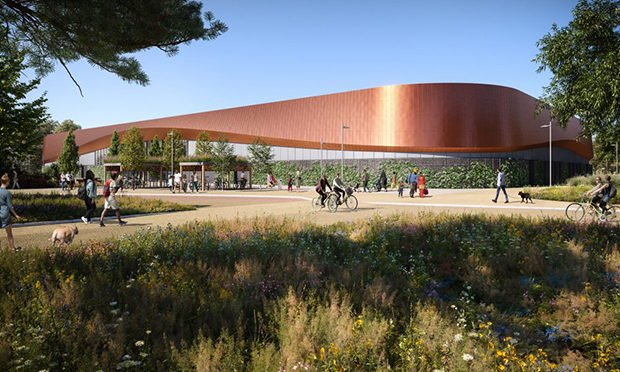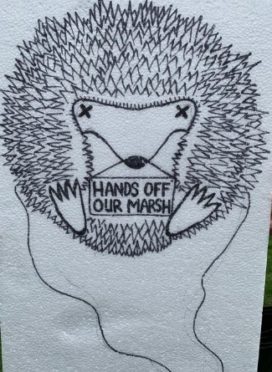Campaigners hold Leyton Marsh ghost hedgehog protest opposing new ice centre

Campaigners took to Leyton Marsh in protest last weekend plans to build a new community twin pad ice centre, approved recently despite their warnings that the building’s proposed footprint would “permanently destroy” wildlife habitats and trees.
Save Lea Marshes (SLM) protesters carried and laid the ghosts of hedgehogs on the land to represent the loss of the animals’ habitats, with the campaign arguing that the planned international venue could have been built on the Olympic Park instead.
The redevelopment was given the go-ahead last month by Waltham Forest Council with the support of Hackney Town Hall.
The land on which the centre sits is classified as Metropolitan Open Land, on which only ‘very special circumstances’ can justify such plans, with Waltham Forest officers pointing to an assessment and review from Sport England confirming that there is a demand for regional ice time that cannot currently be met by other facilities across London.
A spokesperson for Save Lea Marshes (SLM) said: “Despite the horrendous weather, we staged a punchy protest on Leyton Marsh against siting a new Olympic facility there.
“We know that the Greater London Authority considered the plans not to be compliant with the London Plan. We hope the Mayor of London intervenes to call in the decision to grant permission and we will be continuing our campaign.”
Responding to any argument from the Lee Valley Regional Park Authority (LVRPA) pointing to community need and ecological improvements as part of the plans, SLM added: “Actually there is not going to be any improvement, from chopping down twenty mature trees, to taking down a hedgerow, to using part of the special importance of nature conservation site as a construction site, and pumping ice water into the Lea.”
Having been approved by Waltham Forest’s planning committee, the project is now being referred for consideration by London Mayor Sadiq Khan, with the LVRPA arguing that the building will be “highly sustainable”, pointing to environmental improvements as part of the scheme which it predicts will result in a biodiversity gain of over 35 per cent.
LVRPA have also pledged to fund a community programme of a quarter of a million pounds to open up access to the venue for Waltham Forest and Hackney’s schools.

Writer and journalist Lucy Jones said: “Walking on Lea Marshes and connecting with the rest of the living world under open skies helped save my life when I was recovering from addiction and depression in 2012.
“We are nature, and the more it is destroyed, the more it affects our minds. Communing with the living world affects us from our minds to our toes and, in light of the now unequivocal scientific evidence, encroaching on open space and the natural habitats of Leyton Marsh with a new ice centre is a mindless, destructive and abhorrent proposal that will destroy the homes of many nonhuman beings.”
Chef and broadcaster Andi Oliver added: “I have lived here for 20 years and developers come again and again to try to build. Again and again we see communities like ours being ignored and marginalised. It’s not fair, it’s not democratic and it must stop.
“We have the right to our green spaces, it’s vital for our mental health and in the current pandemic and beyond also for our physical health, we deserve to be heard. This terrible decision needs to be overturned.”
SLM has warned that the plans will see a loss of “precious open space” and mature trees, as well as seeing the Marsh become a construction site, involving the excavation of contaminated land.
The current centre has been used for 34 years, with Waltham Forest arguing that, as it nears the end of its operational life, its closure would spell “the end of ice activities in East London” without a replacement, pointing to a centre which will offer two Olympic-sized rinks, with a doubling in capacity to 557,000 visits per year, and room for 800 spectators, though Lea Bridge ward councillor Ian Rathbone has warned of the transport impact this could have on the area.
Rathbone said: “What we are seeing is something predicted for some years now by us and Save Lea Marshes group – the slow and sure taking away of our open and green land by private and other developers building on it for their own financial ends, and somehow justifying the means of destroying wildlife and natural environment forever.
“I feel some people have had the wool pulled over their eyes by a dangling carrot of the attraction of an ‘international venue’ ice rink which for local people in our ward means the dreaded flooding of their quiet streets with parked cars and people walking through to the rink by crossing the river.
“It also means further pollution and noise from the huge boost to the already congested Lea Bridge Road traffic and the consequent impact back through Hackney and on the surrounding wider natural environment.”
An LVRPA spokesperson said: “The new Lee Valley Ice Centre will be more than just an ice rink – it’ll be a community hub providing a safe space for all people, especially young people, to meet, socialise and participate in physical activity and it’ll be a meeting point for walkers, runners, cyclists and families enjoying the brilliant nearby green space of Leyton Marsh.
“When looking for a location we assessed the viability of potential sites, this included land we own at Eton Manor on Queen Elizabeth Olympic Park. However, the studies showed that the current site was the best and most appropriate of all those examined.
“Consultations have found huge appetite among the community and other interest groups for the projects – there were 560 letters of support, compared to 119 against.
“Throughout this process have sought to engage directly with interest groups including Save Lea Marshes to discuss key areas, such as the environment and protection of biodiversity. We can confirm that as part of the new development we’ll be planting 143 trees and will be enhancing the landscape around the ice centre, transforming large areas with low ecological value with significant native planting. This will not only be a vast aesthetic improvement, but the increase in wildlife in the area will result in a biodiversity net gain of over 35 per cent.”
